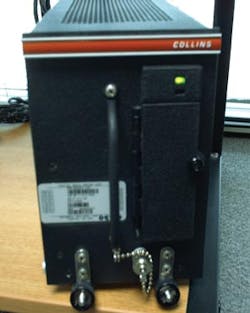This all too common phrase is often the source of dread for many parents taking the family on a planned outing. The utterance of these simple words is the usual indication of the onset of severe boredom. Of course another interpretation might be "Where exactly are we"? Followed by "How long will it be until we have reached the journey's end?" This is a situation that not only parents have to contend with but often plagues aircrew members. With the evolution of longer range transport aircraft one of the leading questions for aircraft operators is how to keep the passengers occupied during the journey. What may hold the attention of a pre-teenage child is probably not going to do a lot for the middle-aged chief financial officer being transported to a shareholders' meeting in some far-off destination.
Staying in touch
A means of staying in touch is a necessity in today's business travel environment and a device that can deliver not only stock market data but world news and weather along with pertinent information about the flight has become a reality on many corporate aircraft.
The Collins Airshow system is one such device. A modular concept is adapted for the purpose of presenting text and or graphic displays on monitors available to the passengers and crew. Information pertinent to the current trip such as position and time to destination are obtained by the Airshow computer from the aircraft navigation and air data systems while news, weather, and financial data is obtained through a subscription service using a radiotelephone link with a ground based Network Operations Center.
The content format and sequence of the cabin displays can be defined by the specific aircraft operator at the time a new device is ordered. Even the languages most common to the aircraft passengers can be loaded allowing easy understanding of the information contained on the various text pages. Giving cabin occupants the ability to select the information they most value makes the time spent flying fruitful to those using the system.
The Airshow system
At the center of the system is a box containing a server running the various applications in a Microsoft Windows environment. The unit is designed to operate within the pressure vessel on 28v DC with a power backup to allow a graceful shutdown. Also contained in the box are cooling fans providing an adequate airflow to prevent overheat conditions. An accessible front panel indicator provides a means of reporting fault information. Included is a "power on" indicator which illuminates when the power supply circuit is operational. In addition a BITE Failure indicator will illustrate that an internal defect has been detected. In normal operation this light will illuminate during system startup and extinguish after proper initialization has occurred. Audio connectors are also installed in the case and are wired in parallel with the main audio output to support 300-ohm impedance headsets.
In the flight deck is a controller used by the flight crew to enter a destination airport identifier, Greenwich Mean Time or even a time to destination. A menu function will allow selection of various modes including a preflight briefing and various passenger advisories.
The Airshow reads both digital and analog signals from the aircraft onboard avionics systems. This is accomplished by using up to three ARINC 429 buses. Provisions are also available via USB port to facilitate the installation of a mouse, keyboard, or even a printer.
What's on the menu?
A flight deck display is used to select the option mode. These include national weather, airport weather, destination identification, weather files, aircraft position information, and a means to update the cabin display. Once again the displayed information is decided at the time of system purchase and the content as well as display order is written into the specific software package for that installation. The available data includes geographic maps capable of depicting the route of flight and illustrating real-time aircraft position, previous flight path, and planned route. In addition, place names and points of interest can be displayed. Multi language text pages illustrate real-time flight information including ground speed, altitude, temperature distances, and times. The system also has a feature that produces audio briefings for safety.
A main menu can be displayed in the cabin allowing occupants to make selections from the Airshow network which includes news, sports, weather, and stocks.
In fact the weather information available through WSI uses Doppler radar images combined with text updates which can be used by the flight crew to form a trend analysis of storm cell direction, intensity, and even velocity.
Anytime a new mode is selected a message appears on the video monitor for a short time advising the viewer of the mode currently being displayed. When the network is not being accessed it is typical for the display to cycle through various modes. This is programmable depending on the user's requirements. A typical cycle includes a display of high-resolution maps illustrating aircraft track followed by flight information and then a company logo could be displayed. This sequence would continue for the duration of the flight or until a network selection was made or an override input was given by the flight crew for a safety briefing or other required presentation.
Passenger interaction can be accomplished by a cabin mode selector panel either using one main panel and a binary switching principle or a pulse mode installation which enables multiple switches to be installed throughout the cabin.
Another common installation feature will accommodate a Master Power switch which is in line with most other types of in-flight entertainment systems.
Installation and maintenance
The installation of an Airshow system involves practices that are in line with most other avionics. Any location for electronics should be in an area free of heat sources. There should be adequate space allowance for installation cables and maintenance electrical connectors. There should also be a clear area around the unit of at least 1 inch to allow for proper internal heat dissipation. A common problem encountered with electronic equipment installation especially in newer composite aircraft is locating a good electrical ground for the device. Even the mounting shelf should have an electrical connection to the airframe. In fact precautions should be exercised when the connection is made to apply adequate protection to prevent galvanic action which could disrupt the electrical circuit. The routing of data lines is another area where caution is needed. In some cases locating digital buses near coax antenna cables or high voltage AC wires can cause the data on the bus to become corrupt. Improper termination of shielding around digital buses is another circumstance which can jeopardize the validity of digital information.
Electrical noise finding its way into the Airshow system will result in a degradation of system performance. Plus unnecessary wiring should either be disconnected or at least capped and stowed near the connector.
Maintenance diagnostics play a strong role in the Airshow installation. In fact the ground test procedure is based on sequential completion of five separate validating functions. Each step depends on successful completion of the previous to allow progression. As the Airshow operation is strongly dependent on other aircraft systems it may indicate the presence of certain faults anytime all information is lacking. In addition the result of the tests may appear differently based on specific configurations. This means that two aircraft with the same system installed may not display exactly the same results during the testing phase of operation.
System updates are also handled electronically and the Airshow 4000 Series gives the capability to use a USB key provided by Collins. The installation process is automatic once the key is attached. To initiate the upgrade process the system will first have to be powered and operational. The cabin video display will allow monitoring of the loading sequence and status. Once the USB key is installed the Airshow will verify the information on the key is valid. In the event of bogus data the key will be ignored and the system will continue to function without interruption. Once the information is verified as proper, the part number of the software to be installed is displayed and a 60-second countdown begins. At the end of the time-out the new software will be automatically loaded. If the key is removed prior to the one-minute period the software installation is aborted and the system will go into a restart condition. Once the software upgrade commences it is very important not to remove the USB device until prompted to do so by the system. It is also important to leave the system powered during any software upgrade application.
The design of the system brings troubleshooting to a point of almost being a science. By taking advantage of the maintenance diagnostics and making observations on the display monitors of the various screens, avenues of exploration can be realized and the maintenance screens then used to give a true direction to solving various problems. If for example the aircraft symbol appearing on the moving map periodically goes to a point off the coast of Africa even though the aircraft is flying over West Texas it may be that the position information feeding the Airshow from the aircraft Flight Management System (FMS) may have been lost if even for a moment. By going into the maintenance diagnostic mode a real-time viewing of FMS or any other input data can be monitored and what may appear to be an Airshow problem might be traced to another aircraft system.
Utilization of aircraft telephone connections for Airshow network access is one area that can pose a drawback. The high costs associated with some Satellite Communications (SATCOM) Systems can make system demonstrations and even troubleshooting sessions very costly events.
Well I guess that now we know the answer to "when do we get there"? I guess the only other thing is "when do we eat"? AMT
About the Author

Jim Sparks
Jim Sparks has been maintaining aircraft for almost 40 years with the majority of the time involving Business Aviation activities. Jim’s endeavors have placed him on six of the seven continents contending with numerous situations from routine flight dispatch to critical AOGs. His career includes maintainer, avionics/electrician, educator, tech rep, and director of aircraft maintenance. In addition to other activities he is engaged with ASTM assisting in the global development of criteria defining the Next Tech for NEXTGEN. You can reach him at [email protected].
